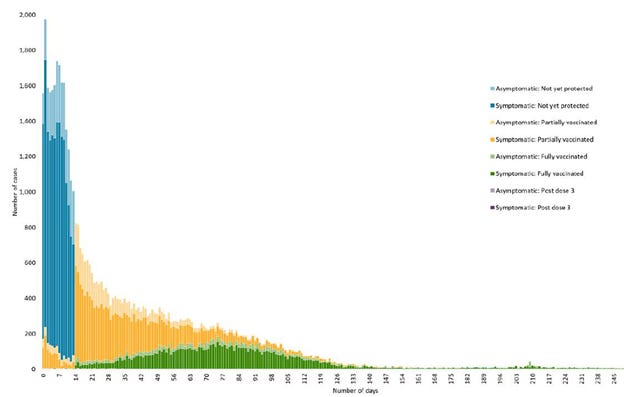Hiding in Plain Sight
Vaccination-induced Covid cases are so easy to spot, wonder why it's not a more popular topic.
We are told now, in the fall of 2021, that although Covid-19 vaccinations are not preventing infections or infectivity, “as of Delta”, they surely decrease one’s chances of hospitalization, complications, or death. Although concrete numbers are wonting, on the subject of skewed testing (toward unvaccinated), dubious classifications, and rigged reporting, all driven by the ever-pressing need to force more vaccinations, there are still some interesting bits seeping through the cracks of the official narrative edifice every now and then from various corners of the world. Until they make too much of a splash and get safely swept under the carpet by the global censorship asphalt roller, lest they induce vaccine hesitancy and/or public health misinformation of the most vicious kind.
The latest case at hand: Ontario (https://www.publichealthontario.ca/-/media/documents/ncov/epi/covid-19-epi-confirmed-cases-post-vaccination.pdf?la=en) and Alberta (https://www.alberta.ca/stats/covid-19-alberta-statistics.htm#vaccine-outcomes) reports on Covid-19 cases in vaccinees depending on the timing and dose of the vaccine.
As Ontario report lumps up all cases between Dec. 14, 2020 and Oct. 17, 2021, the conclusions about the prevalence of cases/hospitalizations/deaths are meaningless as there were barely any vaccines at the first half of this period. Ditto for Alberta report that lumps up these data for the past 120 days and as the vaccinated/unvaccinated ratios were quite fluid in the period.
But what is eye-catching is the data on the Covid-19 cases by the vaccination status. This is a solid data set hard to rig. It does allow us to draw some concrete conclusions, which we’ll do in short order after presenting the data. So, without further ado:
Figure 12 of Alberta the report on vaccination outcomes. The time from first dose (left) and second dose immunization (right) to COVID-19 diagnosis by age group in Alberta (presumably Jun. 26, 2021-Oct. 26, 2021):
Note: First dose immunization also includes people who became a case prior to their second dose immunization date. COVID-19 hospitalizations reported are not due to immunization events.
And then somewhat comparable data from Ontario:
Note: Post-vaccination cases are shown as per the Definition of Terms. Partially vaccinated cases are shown as 14+ days after dose 1 and 0-13 days after dose 2. Breakthrough cases are shown as 14+ days after dose 2 and 0-13 days after dose 3. Post-dose 3 cases are shown 14+ days after dose 3.
Let start sleuthing around. It looks like both datasets are generally in agreement regarding these points:
- 1st jabbed experience a huge spike in Covid-19 cases in roughly 20 first days post-jab, and then subsiding more slowly for up to 4 months;
- The 2nd jabbed experience an initial smaller spike in days 10-14 post-jab, then a lull for 2-3 weeks, flowed by a 2-3 month wide peak of case incidence centered at about day 80-90 after the 2nd jab, and then another blimp on the radar at about 7 months post 2nd jab.
Time for speculation! As we know, jabbing induces the weakening of the immune system as the body has to deal with an injected foreign agent and mobilize its immune system to figure it out. Hence the 14-18 days of the increased incidence in both cases, less pronounced the second time. So far so good.
The larger “hill” at 3 months post 2nd jab with Covid-19 cases after the 2nd jab looks odd. It may have to do with the dynamics of the vaccinations
and cases
this past summer. As the bulk of vaccinations concluded by Aug. 1, and there has been a spike in cases in October (3 months later), we see this as an artifact on the charts. Except to say that the height of the peek immediately after the 2nd jab is comparable to the one produced by the real spike in Covid-19 cases in October. And the spike produced by the first jab is 8 to 10 times bigger than that! In other words, vaccination in itself produces spikes in cases commensurate with the waves of the pandemic itself, or even much higher! Who needs a pandemic if there is a vaccine?
And what about the blimp on the radar 7 months post 2nd jab? That, my friends, may be the emerging evidence of “waning immunity” - an AIDS-like weakening of one’s immune system given enough time for the vaccine to work its magic on one’s immune system (https://theexpose.uk/2021/10/23/government-reports-suggest-fully-vaccinated-develop-ade-by-the-end-of-the-year/).
Not to overload dear readers with too much information at one sitting, the pursuit of these leads will be followed up in subsequent articles. By now, check the provided links and have a go at my musings.






Do you think the spikes around vaccination time are due to the vaccination locations themselves being covid reservoirs? Nosocomial and institutional locations seem the most reliable and consistent sources of infection.
The other thing I have been wondering (that we will never know) is batch-related issues re: vaccine side effects. eg: 8 babies all died a few weeks post-birth with brain bleeds.
I'm unvaccinated and plan to stay that way anything forced is wrong